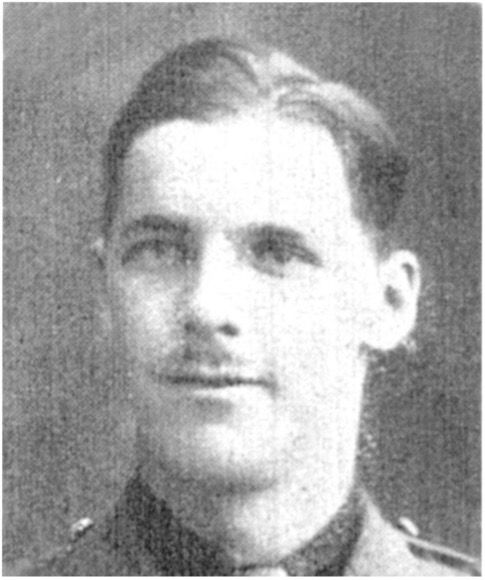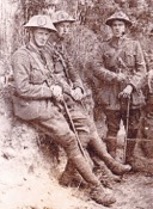George Mortimer Langdon Goodall

| Rank: | Second Lieutenant |
| Regiment: | East Lancashire Regiment, 2nd Batallion |
| Country: | France |
| Cemetary/Memorial: | Le Trou Aid Post Cemetery Fleurbaix, (Plot: I. 1) |
| Awards: | British War Medal Victory Medal 1914-1915 Star |
Born on 4th April 1894, in Hampstead, London, Second Lieutenant Goodall was killed in action on 9th May 1915, aged 21.
He was the second son of Montague Goodall (1865-1929) and Lucy Goodall (nee Tattersfield, 1862-1889), of Hampstead, London. His father was a wholesale stationer. He had a younger sister, Edith Constance Winifred (1894-1963) as well as three brothers: Charles Montague (1892-1978), Harold Martin (1897-1968) and Laurence Maynard (1898-1987) .
He was husband to Dorothy Ida George whom he married in March 1915, a few days before leaving for active service in France.
George followed his elder brother, Charles, to St Ronan’s in May 1902. All four boys attended Saint Ronan’s and their father presented a silver challenge cup, “The Goodall Cup” for best pupil to mark the boys’ success there.
On his first Sports Day he came first in the junior 100 and 220 yards. At the end of that school year he won the prize for Latin, Greek and Mathematics.
In the June 1903 exams he scored 113 out of 550 coming last in his class. By the following October he had improved, scoring 297 out of 500 putting him in third place in his class and at the end of that term he won a drawing prize.
In 1905 he won the Freehand Drawing Prize and both he and his brother won the Sunday Work Prize and the English Prize.
George played as a back in football and in 1903 it was said of him “a bit too young and light for his place.” and “inexperienced” and in 1904 “played fairly well, but he is rather inclined to get in other peoples way” but in 1905 he was described as “promising”.
Of his Cricketing skills in 1908 it was noted “has improved both his batting and fielding; unfortunately he has never been able to cure himself of the habit of hitting across, so the first straight ball bowls him”.
By the time he left Saint Ronan’s in 1907, George had been both Head Prefect and Head of School, and was praised in The Ronian for being a boy, “like all the Goodalls, on whom great reliance could be placed”, and who had great strength of character.
In September 1908, George went on to Greshams where The Ronian recorded his progress: “in addition to winning the Hobby prize, and receiving special praise for his work, has got his first XV colours.”
He was in Howson’s House and by the end of his first year he won a prize for maths and taken part in swimming races for his House. His father contributed to the cricket pavillion.
In 1910, George played football for the school, and was later awarded colours, but it is the prize he won for Hobbies in recognition of the high standard of his beautifully illustrated nature notebook that stands out. The small volume is a treasured part of the Gresham School Archives, much admired for its meticulous drawings of moths and butterflies, as well as its diagrams of the scientific methods of trapping the insects. He would have been 16 years old.

In 1911 George played the part of an officer in the annual Shakespeare play, The Taming of the Shrew.
In 1912, The Ronian reported that “Goodall….who is a Prefect in his house and also a member of the rugby XV, is hard at work on an aeroplane. We understand he may arrive like “a bolt from the blue” at any moment on the S. Ronan’s Football field” and “We congratulate G.M.L Goodall on achieving fame as a designer of Aeroplanes. In the recent edition of “Flight” we read with great admiration, but little comprehension, an enthusiastic account of the advantages of his own particular machine. One day we may be tempted to essay a flight under his care”.
Also in 1911 he demonstrated another aspect of his artistic talent when he read a paper on aerodynamics to the Scientific Society, carefully explaining the different types of aeroplane and their advantages, illustrating his talk with two of his own models. An article in Flight magazine for 1912 praised his design for a hydroplane as being remarkable in more ways than one.

George’s model glider which carried a weight of 2lb per square foot and achieved a velocity of 35mph Flight Magazine, 1912
The Ronian reported his success as follows: “Goodall…. who is a Prefect in his house and also a member of the Rugby XV, is hard at work on an aeroplane. We understand he may arrive like “a bolt from the blue” at any moment on the S. Ronan’s Football field” and “We congratulate G.M.L. Goodall on achieving fame as a designer of Aeroplanes. In the recent edition of “Flight’ we read with great admiration, but little comprehension, an enthusiastic account of the advantages of his own particular machine. One day we may be tempted to essay a flight under his care”.
On leaving Gresham in July 1912 George went to train at Cirencester Agricultural College before leaving for Canada in April 1913 to work on farms in Nova Scotia and Toronto.
In 1914 he is reported as entering, as a ‘premium pupil’, the Bristol Aeroplane Works ,which were already turning out six machines in a week. At the outbreak of war, George was eager to enlist but his managers were reluctant to let him go. However, in October they gave way and he joined the Public School Battalion of the Middlesex Regiment from which he got a commission to the 3rd Battalion, East Lancashire Regiment in November. In October 1914, The London Gazette, reported his move from the Officer Training Corps to Second Lieutenant with the East Lancashire Regiment. Ironically, given his aviation experience, he did not hear anything of his application to join the Royal Flying Corps until he was in hospital in Boulogne in April, having been sent out to the front in March with the 2nd Battalion.
At the outbreak of War, the Second Battalion had been stationed in South Africa and was returned to England. On 6th November 1914, they were mobilised for war and landed at Le Havre. They were engaged in various actions on the Western Front and the Battalion is known to have taken part in the Christmas Truce of 1914.
During 1915, they were involved in the Battle of Neuve Chapelle, the Battle of Aubers and the action of Bois Grenier.
George died during the disastrous campaign to take German trenches at Aubers Ridge beyond Neuve Chapelle which began on 9th May 1915. He was killed leading his men in an attack during which his regiment reached the German trenches but were practically annihilated by machine gun fire. His body was laid to rest in Le Trou Aid Post Cemetery, Fleurbaix, one of only 149 there with any identification.
 From the beginning it was thought doubtful that the plan to take Aubers Ridge would succeed, as the Germans were aware of the coming officensive and shelled the British trenches systematically. Furthermore, the British lines were in full view of the enemy. The British bombardment began, nonetheless, at 5:00am on 9th May and seemed a great success, although it had in fact been ineffective. The men who moved forward were met by continuous rifle and machine gun fire. At 1:00pm the British bombardment began again, but this time the shrapnel was hitting the British soldiers themselves. At the end of the “most disastrous day, with one possible exception, that the batallion experienced during the war”, the casulaties were ten officers killed, including Goodall, with a further nine wounded, 63 ranks killed, 325 wounded and 42 men missing.
From the beginning it was thought doubtful that the plan to take Aubers Ridge would succeed, as the Germans were aware of the coming officensive and shelled the British trenches systematically. Furthermore, the British lines were in full view of the enemy. The British bombardment began, nonetheless, at 5:00am on 9th May and seemed a great success, although it had in fact been ineffective. The men who moved forward were met by continuous rifle and machine gun fire. At 1:00pm the British bombardment began again, but this time the shrapnel was hitting the British soldiers themselves. At the end of the “most disastrous day, with one possible exception, that the batallion experienced during the war”, the casulaties were ten officers killed, including Goodall, with a further nine wounded, 63 ranks killed, 325 wounded and 42 men missing.
After his death the following obituary appeared in The Ronian:
“G M L Goodall, the 2nd son of Mr. and Mrs. Montague Goodall, left S. Ronan’s in 1908, and went to Gresham’s School, Holt. At S. Ronan’s he was Head Prefect and Head of the School during his last year, and was also in the cricket IX. He was a boy, like all the Goodalls, on whom great reliance could be placed, and he had considerable force of character. At Gresham’s he did remarkably well, and was high up in the school when he left, as well as being a School Prefect and in the Rugby IX. He had a great bent for Natural History, and won several prizes in that connection. George was a fine fellow, and his loss will be deeply felt by his many friends.”
It also reported his death saying simply, “George was a fine fellow, and his loss will be deeply felt by his many friends.”
An interesting twist in George’s story came to light with a scribbled remark on his service record beside the note of his father being next of kin, reading: ‘Wait. There’s a widow.’
Following their rather hasty wedding in Plymouth in March 1915, a few days before George had started active service, Dorothy Goodall apparently led a very jolly life. She marked the news of her husband’s death by drinking with three officers in a nearby hotel! Her claim for a widow’s pension was turned down on the basis of her ‘immoral life’ and the fact that the Goodall family knew nothing of the marriage until afterwards.
His brother, Charles, also served in the War, as a Captain and Intelligence Officer of the Northumberland Fusiliers and was awarded the Military Cross for his gallantry.
Following Pembroke College, Cambridge, younger brother Harold went on to become a Lieutenant with the Worcestershire Regiment.
